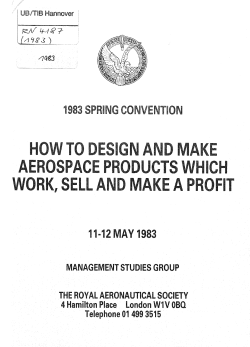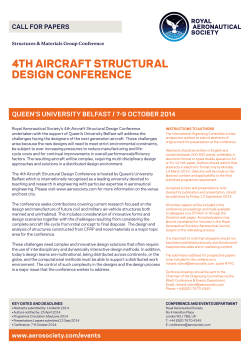
Producing technical details for aeronautical engineering activities
SEMAE3190 Producing technical details for aeronautical engineering activities Overview This standard identifies the competences you need to produce technical details for aeronautical engineering activities, in accordance with approved procedures. The scope of the standard requires you to produce technical details in the correct form for engineering activities to take place, and to pass them on to the appropriate people within agreed timescales, whilst ensuring that the activities within your control conform to organisational and legal requirements. Your responsibilities will require you to comply with organisational policy and procedures for producing the technical details. You will report any problems that you cannot personally resolve, or that are outside your permitted authority, to the relevant people. You will be expected to work with a minimum of supervision, taking personal responsibility for your own actions and for the quality and accuracy of the work that you carry out. Your underpinning knowledge will provide a good understanding of your work and will provide an informed approach to gathering appropriate information, determining the technical information required and presenting the required details in the required formats. You will understand your organisation's methods of operation in sufficient detail to enable you to make informed decisions. You will be aware of any health, safety and environmental requirements applicable to your area of responsibility. You will be required to demonstrate safe working practices throughout and will understand the responsibility you owe to yourself and others in the workplace. SEMAE3190 Producing technical details for aeronautical engineering activities 1 SEMAE3190 Producing technical details for aeronautical engineering activities Performance criteria You must be able to: P1 P2 P3 P4 P5 P6 produce technical details that contain all the relevant and necessary data for the engineering activity to be carried out present the technical details in the appropriate formats make sure that codes and other references used in the technical details follow agreed conventions pass on the technical details to the appropriate people within agreed timescales record technical details and store them securely in accordance with organisational requirements undertake changes to technical details within agreed control procedures SEMAE3190 Producing technical details for aeronautical engineering activities 2 SEMAE3190 Producing technical details for aeronautical engineering activities Knowledge and understanding You need to know and understand: K1 K2 K3 K4 K5 K6 K7 K8 K9 K10 K11 K12 K13 K14 K15 K16 K17 K18 K19 K20 how to access information on health and safety regulations and guidelines relating to the technical detail being produced the implications of not taking account of legislation, regulations, standards and guidelines when specifying the technical details how to obtain information on the engineering requirements, and the type of information that is available (such as customer order requirements and instructions, quality control requirements and the product specification) how to extract information from engineering drawings and related specifications (to include symbols and conventions to appropriate BS, ISO or BSEN standards) in relation to work undertaken the materials, formats, codes and conventions that are used in presenting the technical details the types of data that should be included in the technical details you are producing the factors to be taken into account when determining the technical details, especially those covering working conditions and safety the development of the technical details (to include both master documents and working instructions, along with their purpose, content and status) how to prepare the technical details (to include the structure, style, clarity and compliance with relevant standards) the process used in the organisation to validate the technical details produced the control procedure for ensuring that the technical details are maintained up to date the procedures for changing technical details and why control procedures are used the importance of maintaining records, what needs to be recorded and where records are kept how to access and use the appropriate information and documentation systems the different ways of presenting information to different people the importance of providing the right information at the right time the problems that can occur with specifying technical details for engineering requirements and how they can be minimised the extent of your own authority and to whom you should report in the event of problems that you cannot resolve the sources of technical expertise if you have problems that you cannot resolve the organisational procedures for providing information to different people SEMAE3190 Producing technical details for aeronautical engineering activities 3 SEMAE3190 Producing technical details for aeronautical engineering activities Additional Information Scope/range related to performance criteria You must be able to: 1. Carry out all of the following when determining and producing the technical details: 1.1 use the correct issue of company information 1.2 check that all essential information and data needed, to identify the technical requirements and to derive the technical details, are available 1.3 ensure that health and safety regulations and safe working practices are taken into account 1.4 ensure that the influence of working conditions on technical performance is recognised and included in the technical details 1.5 present the technical details in the appropriate formats 1.6 resolve any problems as they occur, within your level of responsibility 2. Produce technical details for three of the following aeronautical engineering activities: 2.1 machining activities (such as milling, turning, grinding, pressing) 2.2 assembly activities (such as mechanical, airframe, fluid power, electrical/electronic) 2.3 fabrication activities (such as sheet metal, welding, riveting) 2.4 composite manufacture (such as wet lay-up, pre-preg laminating, resin infusion, blow moulding) 2.5 material processing activities (such as melting and casting, heat treatment, annealing) 2.6 finishing activities (such as stripping finishes, painting, plating, anodising) 2.7 installation activities (such as mechanical equipment installation, electrical/avionic installation) 2.8 modification and repair activities 2.9 operational activities (such as movement of materials, quality systems and audit, scheduled safety audits and risk assessments) 2.10 equipment capability/performance measurement 2.11 commissioning/decommissioning 2.12 lifting and moving large components/assemblies (including transportation/delivery) 2.13 materials handling (such as movement of materials, materials storage, removal of waste) 2.14 plant and equipment (such as plant layout, site preparation, SEMAE3190 Producing technical details for aeronautical engineering activities 4 SEMAE3190 Producing technical details for aeronautical engineering activities equipment changeover, equipment replacement) 2.15 research and development 2.16 maintenance activities (such as preventative maintenance requirements) 2.17 testing and trialling (such as test schedules) 2.18 inspection and quality control 2.19 resource usage (such as materials required, contracted services) 3. Include five of the following in the technical detail: 3.1 equipment operating detail (function) 3.2 resource requirements 3.3 equipment performance parameters 3.4 interfacing 3.5 physical characteristics (dimensions, weight) 3.6 specific or specialist equipment required 3.7 environmental considerations/operating conditions 3.8 materials required/used 3.9 manufacturing methods 3.10 timing/delivery details 3.11 manufacturing detail 3.12 cost/budget estimation/details 3.13 processing requirements 3.14 training required 3.15 work instructions or procedures 3.16 safety requirements 3.17 number/volume required 4. Take account of applicable local and national standards and conventions when producing the technical details, to include five of the following: 4.1 terminology 4.2 referencing and indexing 4.3 nomenclature 4.4 geometric tolerancing 4.5 colour codes 4.6 document format and layout 4.7 symbols and abbreviations 4.8 safe working practice and procedures 4.9 company instructions 4.10 military specifications 5. Ensure that the technical details comply with two of the following: 5.1 Civil Aviation Authority (CAA)/European Aviation Safety Agency (EASA) 5.2 Ministry of Defence (MoD) 5.3 Military Aviation Authority (MAA) SEMAE3190 Producing technical details for aeronautical engineering activities 5 SEMAE3190 Producing technical details for aeronautical engineering activities 5.4 5.5 5.6 5.7 5.8 5.9 6. Aerospace Quality Management Standards (AS) Federal Aviation Authority (FAA) BS, ISO or BSEN procedures company policy and procedures customer policy and procedures aircraft manufacturer's requirements Present the technical detail using the following method: 6.1 verbally Plus one more method from the following: 6.2 written or typed report 6.3 specific company documentation 6.4 electronic mail 6.5 computer based presentation 6.6 other appropriate media SEMAE3190 Producing technical details for aeronautical engineering activities 6 SEMAE3190 Producing technical details for aeronautical engineering activities Developed by SEMTA Version number 2 Date approved March 2014 Indicative review date April 2017 Validity Current Status Original Originating organisation SEMTA Original URN O45NAER3190 Relevant occupations Engineering Professionals; Engineering and manufacturing technologies; Engineering; Science and Engineering Technicians Suite Aeronautical engineering suite 3 Key words producing technical details; aeronautical; engineering activities; timescales; organisational policy SEMAE3190 Producing technical details for aeronautical engineering activities 7
© Copyright 2025










